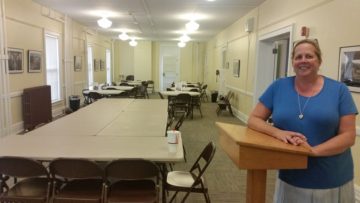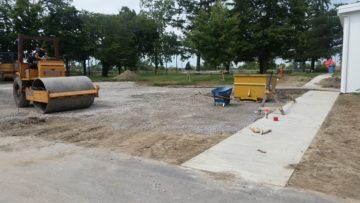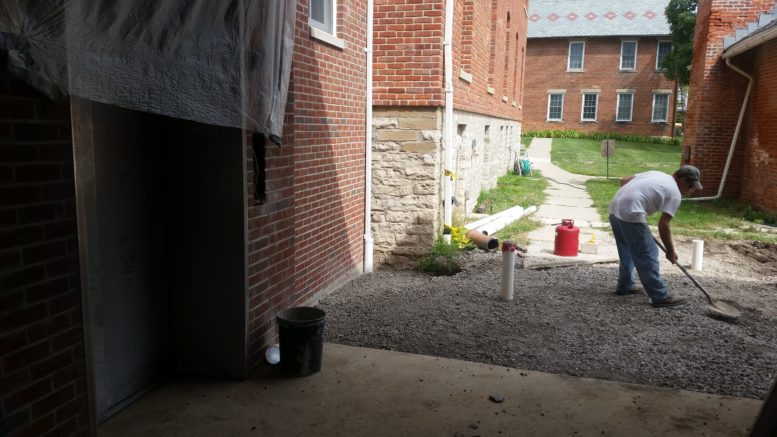By JAN LARSON McLAUGHLIN
BG Independent News
More than a century ago, the Wood County Infirmary was a place of refuge for the sick, the elderly and the poor. Now, a historical museum, the site is again reaching out to those who need a little extra help.
After months of renovations, the Wood County Historical Center will soon be fully accessible to the public. And museum staff will no longer have to disappoint physically handicapped guests by informing them that their visits will be limited to the first floor, explained Director Dana Nemeth.
By the end of September, the historical center will be furnished with an elevator and handicapped accessible restrooms.
“This building was meant to serve the community when it was a social welfare site,” said Holly Hartlerode Uppal, curator of the museum. “We gave people an opportunity to start over.”
Though some have questioned the renovations to the historical building, Hartlerode Uppal believes the operators of the county infirmary would approve.
“They would be very excited about all the improvements,” she said. “They did their best to take care of people and we are doing our best now.”
The $1.2 million renovation, assisted by the state and county, has been extensive. The elevator will make stops at the basement, ground floor, first and second floors, and the attic. Because the west wing of the historical center is a couple steps lower than the center and east wings, the project required that indoor ramps be built on the first and second floors.
The elevator will be accessible from the outside of the back of the building. A connecting driveway is being extended from the parking lot to the east, an ADA parking lot is being added just to the west of the elevator, and the driveway on the west will be expanded so buses can make the turn to access the elevator.

Wood County Historical Center Director Dana Nemeth stands in new meeting room.
The renovations also created four handicapped accessible restrooms, and a larger meeting room that can be rented out.
The project will not only make it easier for people to move about the museum, but also make it easier for people to move some really heavy exhibit pieces.
In fact, one room in the west wing is full right now of very heavy artifacts that staff would rather move with the aid of the elevator. That includes a cast iron stove, two organs, three pianos, a model oil derrick, old washing machines, ice boxes and a corn sheller.
“We can move things more easily,” Nemeth said. And that’s good for the staff and the stuff.”
“It’s better care for our collections if I don’t have to lug them up and down three floors,” Hartlerode Uppal said.
Since the former county infirmary is on the National Register of Historic Places, it is exempt from ADA requirements. However, that just didn’t seem right, especially considering the former use of the building, Nemeth said.
“Because we’re a historic site, we don’t have to be accessible. We get a free pass,” Nemeth said. “But we all feel a public building should be accessible.”

Handicapped accessible parking area is being added near the elevator.
Since the elevator project has been under construction, Nemeth has heard from several people who are looking forward to the completion. She has talked to people who previously volunteered at the site but can no longer navigate stairs.
“They are excited about being able to come back again,” she said.
Then there’s the “Mommy and Me Program,” in which parents take small children through the museum in strollers. There are people with vision problems, and knee issues – all who would be more comfortable using an elevator. And “a lot of our audience is older,” Hartlerode Uppal said.
The historical center staff took care to be sensitive of the building’s historical qualities. Wherever possible, walls were sanded down to reveal the original paint color of the rooms, and that was replicated. Flooring with an old-fashioned pattern was selected. And old restroom signs from the county courthouse were reused.
“We were very careful about changing anything,” Nemeth said.
Adding an elevator to a building constructed in 1869 posed its own issues. For example, the elevator structure had to be positioned to work with the old foundation walls that aren’t exactly straight.
Nemeth credited the contractor, Fochte from Port Clinton, for handling the project expertly. “The quality of their work has been very impressive,” she said.
Because of the historic nature of the site, the construction team found several old items in walls and under the back porch. They unearthed items like old pottery, alcohol bottles, square nail fragments and animal bones.
“The contractors were excellent at stopping” when they found items, Hartlerode Uppal said.
While all the construction is going on in the museum, the staff is also taking the opportunity to change some exhibits.
“It sounded like a good time to make a fresh start,” Nemeth said. “Some of the exhibits hadn’t changed for decades.”
And once the elevator is in operation later this fall, people of all abilities will be able to visit all the exhibits, regardless of what floor they are located on.
When the work is done, Nemeth has plans to take her dad, Dorsey Sergent, on a full tour of the museum. Sergent volunteered at the site for years, but is no longer able to climb the stairs.
“I can’t wait till it’s done, so I can take him upstairs again,” Nemeth said.

